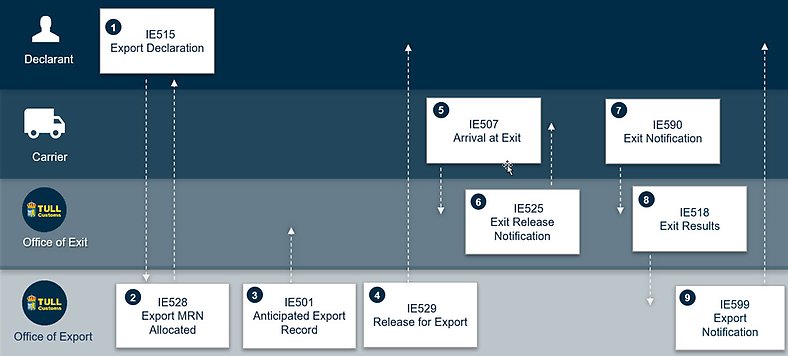
Procedure for standard customs declaration for exports
When goods are exported to countries outside the customs territory of the EU, a customs declaration must be submitted to Swedish Customs. One option is to submit a complete standard customs declaration when the goods are to be exported.
The image below shows the procedure for submitting a standard customs declaration for export. Information is exchanged in separate messages. Below the image are descriptions of what happens at each stage.
 Zoom image
Zoom imageClick on the image to see it in larger format
1. Creating a standard customs declaration
The declarant in the customs declaration creates a standard customs declaration and sends the customs declaration digitally to Swedish Customs in message IE515 to have the goods released for the customs procedure ‘Export’. At this point, the customs declaration contains a Local Reference Number (LRN).
A declarant can also use a representative for their contacts and communication with Swedish Customs. In this case, the agent acts on behalf of the declarant.
2. Receiving the standard customs declaration and assigning MRNs
The customs office of export receives the customs declaration and checks that the data is technically correct for submission.
A case is created at the customs office of export and the customs declaration is assigned an MRN.
The customs office of export sends the MRN to the declarant in message IE528. The customs declaration now has the status ‘Accepted’.
3. Sending a notification of expected arrival
The customs office of export sends the expected arrival information in message IE501 to the customs office of exit specified in the customs declaration.
4. Decision to release the goods for export
The customs office of export ensures that the information in the customs declaration is correct and resolves on the release of the goods. The decision that the goods are released for export is sent by the customs office of export to the declarant in message IE529.
Now the goods can be loaded onto the means of transport that will ship the goods, and the goods can start their journey towards the customs office of exit.
5. Declaring goods to the customs office of exit
When the goods arrive at the customs office of exit, the carrier submits a notification of goods to the customs office of exit in message IE507. The notification refers to the MRN of the customs declaration.
6. Decision to release the goods for exit
The customs office of exit sends a decision to the carrier that the goods are released for exit in message IE525. The goods can now leave the EU customs territory.
7. Notification that the goods have been exported
When the goods have left the customs territory of the EU, the carrier must notify the customs office of exit that the goods have been removed. This is done in message IE590.
8. Sending an exit result
Once the customs office of exit has received the information that the goods have left the Union, the customs office of exit creates an exit result which is sent to the customs office of export in message IE518.
9. Sending a certificate of exit
The customs office of export creates a certificate of exit of the goods and sends it to the declarant in message IE599.
Last updated:
